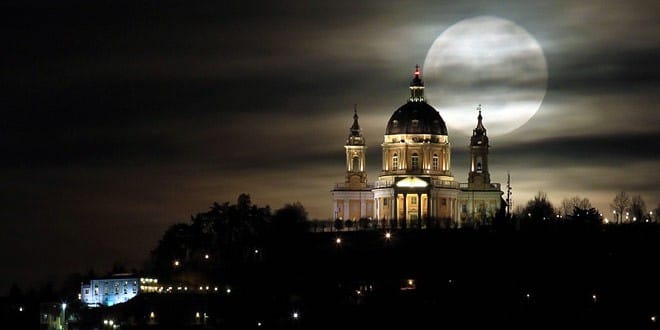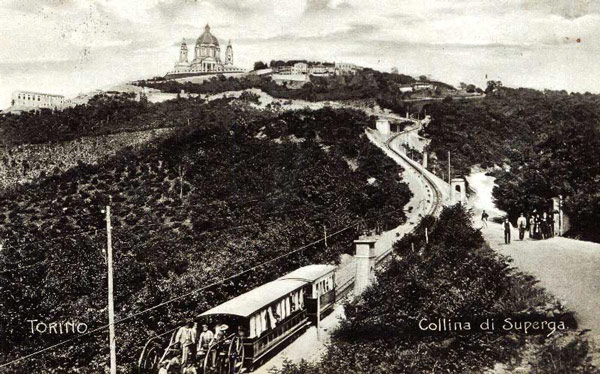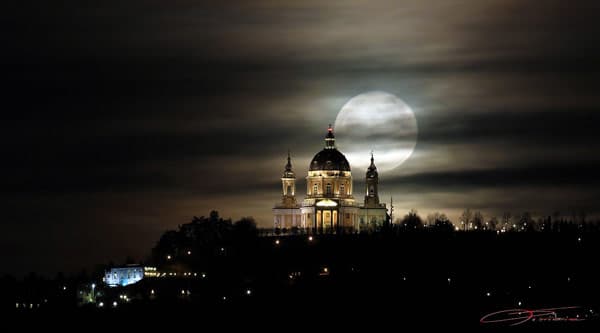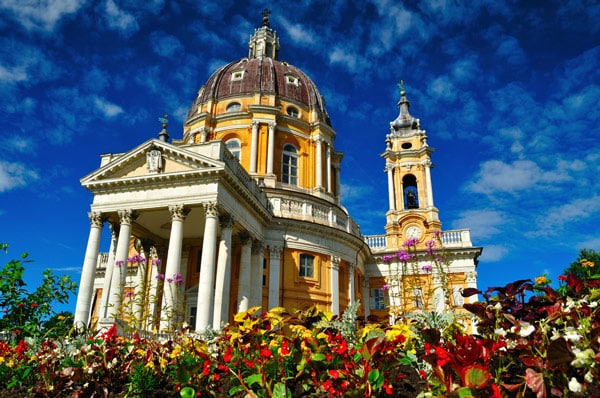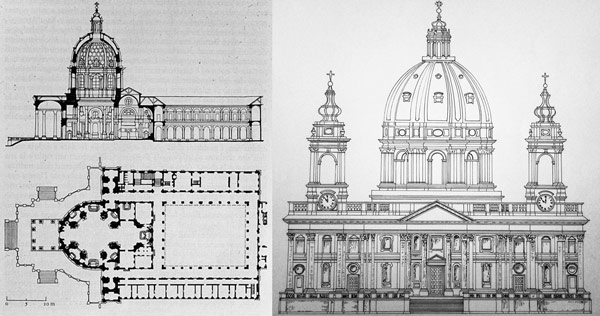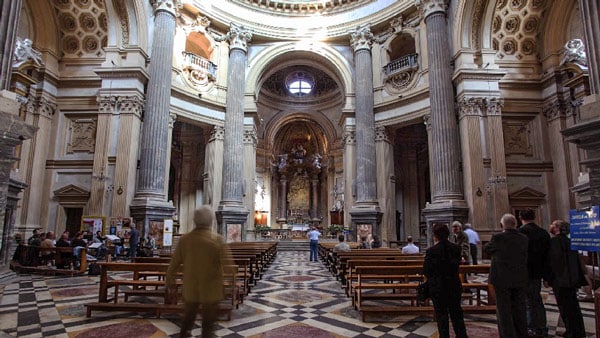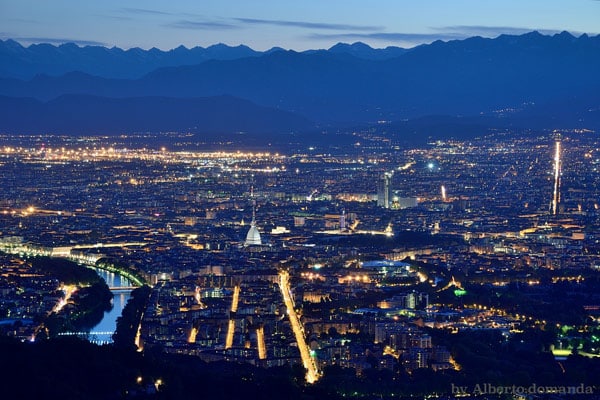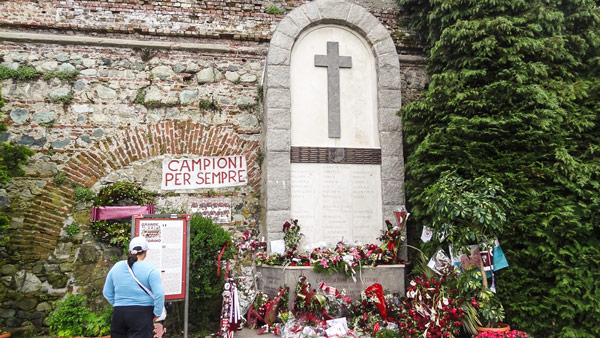Ten kilometers from the city of Turin (Torino), atop the Superga Hill (Il Colle di Superga), from which it got its name, stands the Superga Basilica (La Basilica di Superga) – a place where history and legend converge. This basilica, erected due to a vow, is a church where members of the House of Savoy were buried. It’s also the site of a terrible tragedy that occurred decades ago and is a tourist attraction visited by people from around the world.
Page Contents
History of Basilica of Superga
The decision to build the basilica belonged to Vittorio Amedeo II and was made during the climax of his rule as Duke, amidst the French siege in 1706. Legend has it that Vittorio (who later became the King of Sicily and ruled the Kingdom of Sardinia) climbed to the top of the hill to personally assess the position of the Franco-Spanish invaders, who had occupied Turin for four months.
In prayer, he turned to the Virgin Mary, asking for help in liberating his land from foreigners, and he swore that if successful, he would build a basilica in honor of the Most Holy Virgin Mary at the very spot where he stood. With or without divine intervention, Amedeo II eventually achieved victory, became the King of Sicily, and immediately enlisted the help of the highly talented local architect, Filippo Juvarra.
Two hundred and fifty years after the French siege of Turin, on September 7, 1956, a solemn Mass was held at Superga to honor the memory of all the soldiers who had fallen during those times. It’s worth noting that this service was attended by consuls from Italy, Spain, Austria, and France – representatives of the countries that had fought over the small northern city at that time.
Exterior Facade and Interior Decor of Basilica of Superga
The construction of the Superga Basilica began in 1717 and was completed 14 years later. During construction, it became clear that there was not enough space for the new church on top of the hill, so the architect decided to “trim” the hill’s summit, lowering Superga Hill by nearly 40 meters.
In accordance with Juvarra’s design, the church’s shape still resembles the outlines of the elevation to this day. The circular plan of the structure included two main and four additional chapels.
On each side of the church, symmetrically rising towers can be seen, and at the main entrance of the Superga Basilica, visitors are welcomed by an elongated atrium adorned with eight Corinthian columns.
Turning right upon entering the Church of the Virgin, one can ascend a staircase to a small tower, from where a breathtaking view of Turin, the River Po, and a series of Alpine peaks unfolds.
The landscape here, which you can enjoy, can’t be compared to the view offered to tourists by one of Turin’s main attractions – the Mole Antonelliana tower.
Renowned French painter Henri Rousseau once remarked that the local panorama is “the most beautiful thing a person can ever see.”
To the left of the altar of the Superga Basilica lies a chapel, a favorite pilgrimage spot. It’s right here that the Duke pledged to erect the basilica in honor of the Virgin Mary. This historical moment is depicted in one of the frescoes adorning the chapel. The same story is captured in a painting at the city church of Santa Cristina (Chiesa di Santa Cristina).
Beneath its vaults, Superga conceals a royal mausoleum, where the bodies of many princes and kings from the illustrious House of Savoy rest. This place has served as a tomb for members of the noble family since 1731, with the first tomb being that of Vittorio Amedeo II.
The central chapel serves as a true museum of stunning sculptures and an art gallery with numerous depictions of all the Popes who succeeded St. Peter as the heirs to the Holy See of the Catholic Church.
The Superga Air Disaster
On May 4, 1949, the Superga Basilica witnessed a horrific catastrophe. The pilot of the plane, carrying the players of the superclub “Torino” on their way to a match against “Benfica,” lost orientation due to poor visibility and grazed the basilica’s fence. The aircraft sharply turned away from the impact and crashed into the ground at tremendous speed. All the passengers, including the footballers and three well-known journalists of that time, along with the technicians servicing the plane, perished. This tragedy not only claimed the lives of exceptionally talented athletes but also deeply affected the spirits of all Italians.
The air disaster had an impact on the national team, which included 10 “Torino” players – a record-breaking number of representatives from a single football club in a national team.
Only one “Torino” footballer, Lauro Toma, managed to cheat death. He remained alive because he couldn’t join his colleagues for the match due to an injury.
Today, inside the Superga Basilica, you’ll find a small museum, and nearby, at the site of the plane crash, a memorial stands in memory of the legendary team that lost the most important match of their lives – the match against destiny.
Useful Information
How to Get to the Basilica of Superga
Basilica di Superga is located in the vicinity of Turin at Strada Basilica di Superga, 73, Torino, Italy.
- Walking from the city center (Piazza Castello stop) to the hill will take you approximately 2 hours.
- Taking a taxi to the temple will cost you around 20 euros.
- A budget-friendly option is the funicular (on weekdays, it will cost 4 euros one way, 6 euros round trip, and on weekends, 6 euros one way and 9 euros round trip). To reach the funicular from Turin, you can take bus number 15 from the Piazza Castello stop to the Sassi station (approximately 2 euros), from where you will later transfer to the aerial tramway. Alternatively, you can take buses number 61 and 68, which run from Piazza Vittorio to Sassi (also around 2 euros).
Opening Hours of Basilica of Superga
From March 1st to October 31st, the church is open from 09:30 to 19:00 (the last group of tourists is admitted at 18:15). From November 1st to February 28th, it opens from 10:00 to 18:00 (the last group is admitted at 17:15).
Ticket Prices
5 euros. The tour takes 45 minutes, during which you will have the opportunity to visit the inner courtyard of the church, the central chapel, and other significant places within the basilica.
Official website of Basilica di Superga: www.basilicadisuperga.com
Interesting Facts about the Basilica of Superga
- Historical Significance: The Basilica of Superga, completed in 1731, stands as a symbol of gratitude for the victory of the House of Savoy over the French in the 1706 Battle of Turin.
- Elevated Location: Perched 669 meters (2,195 feet) above sea level on the Superga hill, it offers breathtaking panoramic views of Turin and the surrounding Alpine landscape.
- Royal Tombs: Within the basilica lie the regal resting places of Savoy royalty, including King Vittorio Amedeo II and Queen Anne Marie d’Orléans, creating a regal connection to Italy’s history.
- Mausoleum of Tragedy: The basilica is a poignant reminder of the 1949 Superga air disaster, where an aircraft carrying the entire Torino football team crashed nearby, resulting in the loss of 31 lives.
- Baroque Marvel: This architectural gem by Filippo Juvarra showcases exquisite Baroque design with its monumental dome, opulent interiors, and intricate façade, making it a must-visit for art and history enthusiasts.
 Italy for me From Italy with love
Italy for me From Italy with love

